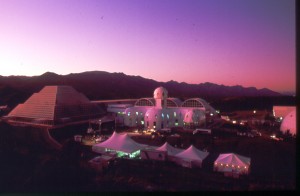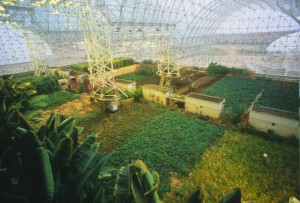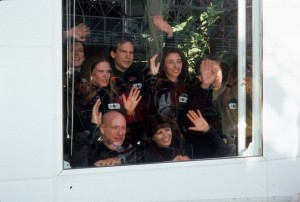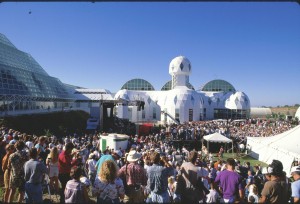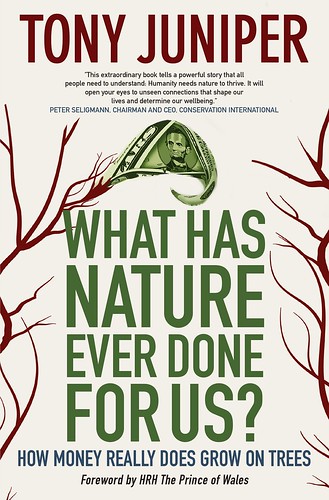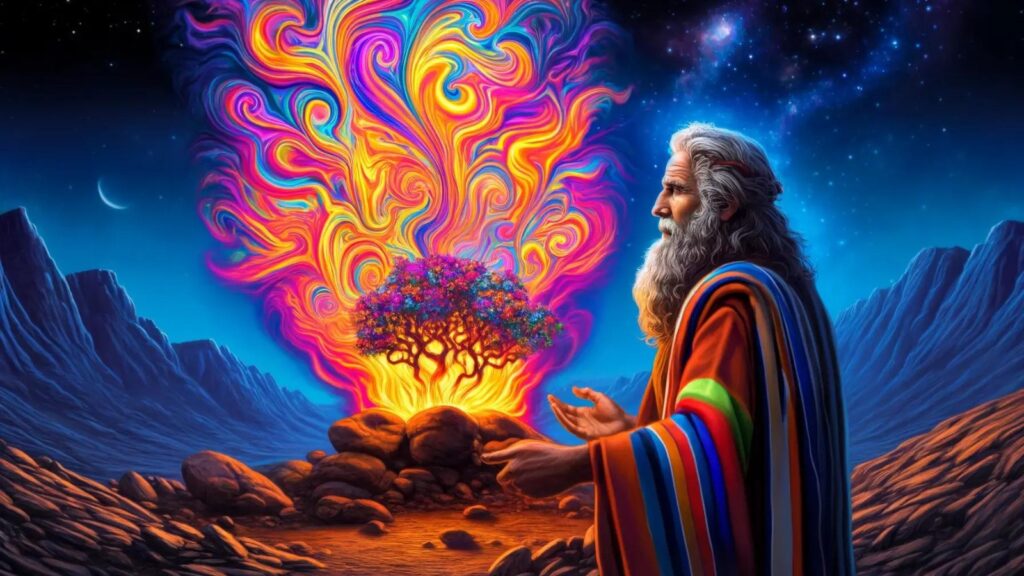The following is excerpted from What Has Nature Ever Done For Us? How Money Really Does Grow On Trees, published by Synergetic Press, and also available through Evolver.
Part II of Prologue – Part I available here.
Here on Earth, They Left Earth
In September 1991, Biosphere 2 was ready. A 1,900-square-meter rainforest had been created. An 850-square-meter ocean, complete with coral reef, had been prepared. A 450-square-meter mangrove wetland, a 1,300-square-meter savannah grassland and a 1,400- square-meter fog desert were all functioning well. The 2,500-square- meter agricultural area was producing the food that would nourish the team. The living quarters were ready. Apart from some electrical power, heating and cooling supplied from outside, once the doors were closed the only things that would go into Biosphere 2 were sunlight and information.
As the Sun came up on September 26, a Crow Indian medicine man, Tibetan Geshe and Toltec Curandera sang prayers. Then Roy Walford, Jane Poynter, Taber MacCallum, Mark Nelson, Sally Sil- verstone, Abigail Alling, Mark Van Thillo and Linda Leigh passed into Biosphere 2. The airtight doors were sealed behind them, and they embarked on a two-year experiment in which they would live and work inside a closed world, one designed to be a microcosm of the Earth and its systems. They would be reliant on the little pieces of carefully selected captive Nature held inside the complex, to recycle waste, purify water, maintain the air and produce their food.
By the time of closure, Biosphere 2 had become a major tourist attraction (William Burroughs was among the celebrity visitors) and the crew entered amid a blaze of publicity. They were a picture of health and vitality. In jumpsuits reminiscent of the super-trained Space Shuttle teams who had made history the decade before, this crew, while earthbound, was to embark on an even more unique voyage.
Like the others, Mark Nelson was prepared for the experiment through a short spell in a test module that was set up as a tiny version of Biosphere 2. He describes his brief taste of what was to come as “An astounding visceral experience. It was only the size of a living room, and at any one time you could see all of the plants that were providing the air you were breathing and a big part of your food. I knew about all these things intellectually, but I wasn’t expecting the extreme pleasure of being so totally connected to the system. I was part of that living system, and extraordinarily thankful it was working to provide all the services I needed. That 24 hours was one of the most astounding experiences I ever had. It really whetted my appetite.”
Despite this, Nelson still found “going in was kind of a shock.” He remembers how “We’d been growing food, testing systems and working together. We’d been working with hordes of scientists and technicians and suddenly when we closed that airlock there were just eight of us in this amazing living system. I went in there with the greatest possible excitement. At the time it was one great leap into the unknown. Some of the technicians were making private bets that we’d be out of there by Christmas, because of carbon diox- ide levels.”
The composition of the air was indeed vital. Also of fundamental importance for their day-to-day wellbeing was a healthy diet. They started with some food grown in Biosphere 2 prior to full closure, but the agricultural system produced more than 80 percent of their food during the first year of the mission. Although their diet included a wide variety of nutritious crops, the team suffered from hunger and lost weight. In the second year, caloric intake increased and they put back on some of the weight they had lost. Despite the ups and downs in food availability, their health was excellent; indeed, certain indicators dramatically improved, such as a large drop in cholesterol levels and improved functioning of immune systems.
The success of the crew in increasing food production was in large part down to how they became more skillful in using the ultimate source of productivity in Biosphere 2: namely, sunlight. “Most farmers are limited by rainfall,” recalls Nelson, “but for us the main limiting factor was sunfall. Any place with sun and without a plant was a waste and you soon fixed that. This didn’t only help with the food situation, but also the carbon dioxide problem. We spent two years filling every possible void with plants. We grew about a tonne more food in the second year, in large part from spaces that were previously underutilized.”
Despite the many strategies that were designed to promote the stability of the systems enclosed in the glass bubble, major changes were soon noted. As expected, carbon dioxide concentrations in the air fluctuated wildly. In the air outside the sealed system, the concentration of this gas was at about 370 parts per million (ppm), and although it was going up (and still is) by a couple of parts per million per year (it reached 396 ppm in 2012), the concentrations of this greenhouse gas are otherwise relatively stable.
Inside Biosphere 2, daily fluctuations were as much as 600 ppm, with a drop during the day as plants took up carbon dioxide, followed by a rise at night when plants naturally released it. Nelson says that “We could sit in the control room and watch the changing conditions. Every fifteen minutes or so the carbon dioxide level would be recal- culated, and even when you couldn’t see through a window you knew when a cloud had gone in front of the sun because the rate of CO2 decline would go down as photosynthesis went down.”
Bigger still was the seasonal fluctuation in concentration, with wintertime levels at 4,000 – 4,500 ppm and in summer around 1,000. The scientists worked hard to keep carbon dioxide levels more stable, through controlling irrigation water to help fast-growing plants to more quickly remove CO2 from the air. They also har- vested plant material from the savannah so as to store it and the carbon it contained.
Less expected was a temporary build-up of trace gases. Even though every care was taken to avoid materials that might release toxic gases, soon after closure something was found to be leaking them. Nelson recalls that “We detected a rise in a trace gas while doing an air analysis and the scientists outside told us that trace gas came from PVC glue or solvents. We fanned out, searching until in a dark corner of the technosphere basement someone found a small bottle of glue. The top had been cross-threaded when it had been closed, so it was releasing gases that we could detect. We resealed it and put it aside and then that gas began to decline.”
More worrying from the point of view of the welfare of the crew inside was the change seen in oxygen levels. Starting with a normal atmospheric concentration for this gas of just below 21 percent, levels fell steadily, and after sixteen months reached 14.5 percent. For the biospherians this was equivalent to the levels of oxygen found at about 4,000 meters above sea level and caused headaches and fatigue, among other symptoms.
To begin with it wasn’t clear why the rise in CO2 levels was happening. One suspected source was the activity of soil microorganisms. It was thought these tiny life-forms broke down carbon- based molecules in the soil more quickly than anticipated, and when carbon atoms were liberated from the chemical bonds which had locked them into the soil’s organic material, they united with the oxygen in the air to form CO2.
This process, it was thought, might lead to an increase in the concentration of carbon dioxide while reducing levels of oxygen. Carbon dioxide levels did not rise as much as expected, however, and experiments revealed that another factor was at work in contributing to the changes measured in the air: CO2 was being absorbed by areas of exposed concrete inside Biosphere 2. Rather like calcium-rich rocks in the real world, CO2 was being laid down as calcium carbonate in B i o s p h e r e 2 ’s equivalent of geological deposits.
Looking back, Allen’s view is that the “biggest engineering mis- take we made was in leaving the bare concrete. We didn’t paint it and so CO2 molecules went in, carrying out oxygen. There was a drop in the oxygen. It took sixteen months, but the levels steadily dropped to the point where people were getting uncomfortable.” It was decided to boost oxygen levels artificially so as to protect the health of the biospherians.
Nelson recalls that “people looking at us from the outside said it was like watching slow motion. This was in part because we were on a low calorie diet, but also because of the oxygen. It got so low that we had to inject some oxygen into one of the lungs to top it up in the facility. When it got down to about 14 percent we all trooped down there and the oxygen in the lung was around 25 percent, before it was released throughout Biosphere 2. People started laugh- ing and running, and then I realized I hadn’t heard a running foot in three or four months.
Being in there when the oxygen was topped up really made you appreciate what you take for granted – clean air, water and food. With- out the biosphere there would be no free oxygen in the air. It’s a stun- ning conclusion, but in there you really knew it. I went down into the lung like a 95-year-old and it was like decades of age went off the body. How many people thank the biosphere for oxygen?”
It was not only in the air that unplanned changes were observed. Some rainforest species grew quickly but suffered from weakness. The same thing happened with the woody species growing in the savannah. This was because of the lack of the winds that in Nature help produce strong and resilient wood. The fog desert began to look more like California chaparral. The mangrove did well and grew rapidly, but was different from such a system in the real world, with far less underg rowth, probably because the space frames reduced the level of sunlight.
Among the fauna, some of the vertebrate species that had been sealed in, such as the birds, ocean fish and reptiles, became extinct or greatly decreased in number. Many of the pollinating insects died out. There was a population boom in pest species, including cockroaches (although happily these undertook some pollinating functions). Sev- eral species of ant that had been deliberately introduced to help main- tain the rainforest declined drastically, and were replaced by a local species that had been sealed in with no one noticing.
There were changes in the ocean. Due to the rapid growth of algae the scientists had to enter the water and remove these plants from the corals by hand to prevent the reef dying. As a result of car- bon dioxide being absorbed into the sea, levels of carbonic acid built up, making the water more acidic. Calcium was added to the seawater to counter this effect as it posed a threat to the whole ocean system and had to be dealt with before serious consequences resulted, including the potential death of the corals, which would not be able to function properly in overly acidic conditions.
Despite these ecological shifts, the crew remained healthy and collected a vast body of data, and on September 26, 1993 – exactly two years after they’d entered Biosphere 2 – they emerged. In addi- tion to shining light on innumerable aspects of how life systems function, they had shown how a creative and healthy human culture can be sustained by a small piece of functioning Nature. The eight- person crew had thrived on 2,000 square meters of farmland, a tiny bit of atmosphere and a small quantity of water. They were the first successful voyagers to another biosphere.
Mark Nelson looks back on those two years and says the experiment gave an important message: “Biosphere 2 helped bring home the fact that humans don’t come in discreet packages that are outside of a biosphere. To live inside that system and to actually feel it in your body was an amazing experience. Your body understood that you shouldn’t damage the plants – it was inconceivable, and you didn’t need to be reminded.”
It seems that the profound messages embodied in the experiment were also noticed by a wider public. “I think for many of the people who came by to see us, it touched a nerve. We had people visiting, almost like pilgrims. It was extraordinarily touching,” he says.
John Allen was delighted with the success of the mission. “They lived in there for two years and left the system more beautiful and self-sustaining than when they went in.” He remains especially proud of their achievements with the agricultural biome. “Half an acre supported eight people for two years, with a half-day working that little piece of land and half the day doing other work. If you scale that up, you could support 10,000 people per square mile with a high-grade diet. Record production was achieved in Biosphere 2, rivaling the highest yields of modern farming.”
Perhaps most important of all, Biosphere 2 provided a powerful and practical lesson as to how our biosphere is the only life support system we have at our disposal. In addition to the demonstration that nonpolluting agriculture, without pesticides, herbicides and chemical fertilizers, could be so productive, the experiment demon- strated how it is possible to design a technosphere that was in the service of life, in harmony with the biosphere. This unique experi- ment also illustrated the limits to human activity, and what could be safely undertaken before life sustaining systems begin to show stress and malfunction.
Having completed their planned work, Allen and his team ceded ownership of Biosphere 2 during a second closure experiment, which began in March 1994. Although this was planned to last until January 1995, it ended earlier. There remains some controversy as to why the second closure was terminated. Although not involved directly, Allen recalls how “everything was running well initially, and then it was shut down after just six months. No reason was given. I suspect they had problems with the soil.” Later, management of the complex was taken over by Columbia University. It is today maintained as a research facility by the University of Arizona.
The pioneering Earth modeling system built at the foot of the Santa Catalina Mountains back in the 1980s was named Biosphere 2 because Biosphere 1 was already in existence. You, I and everyone else are participants within it. It is the Earth’s biosphere, and it is the only one of its kind that we know for sure exists. Biosphere 1 has some fundamental similarities with Biosphere 2, most obviously in that it, too, is a sealed system, and like the facility in the northern Sonora Desert, its only major input is sunlight. The rest of this book is devoted to that miraculous system: the sealed world upon which we and all known life depends. We begin our voyage through Biosphere 1 from the star ting point that is so fundamental for so much of life on land – with what might be called the indispensable dirt. The soil.
